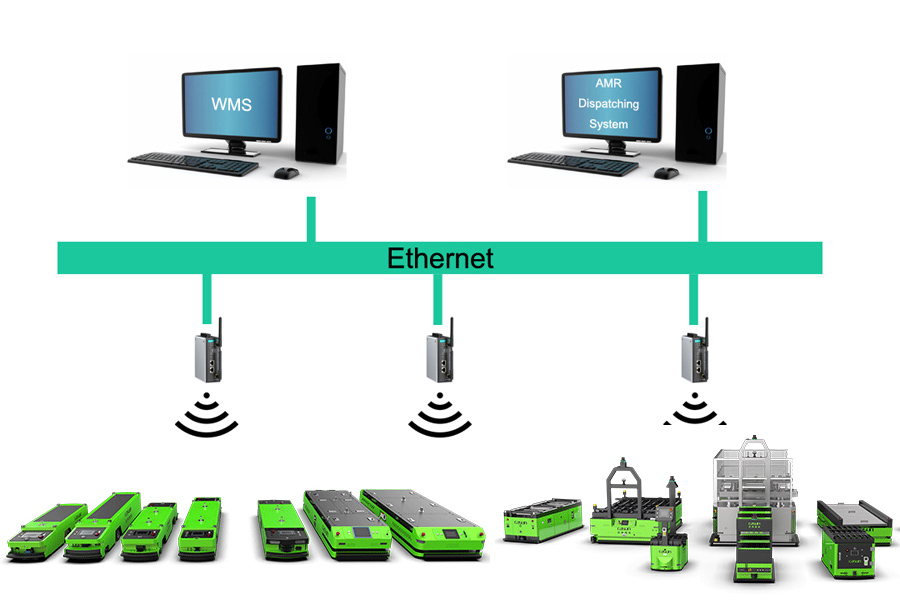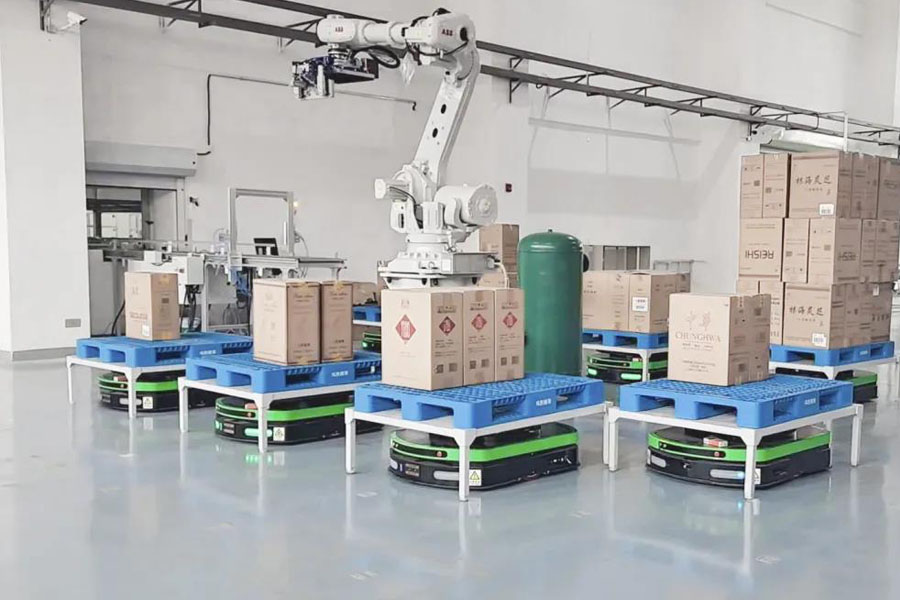Storage safety
- Category A and Category B items and items that are prone to chemical reactions with each other or with different fire fighting methods are strictly prohibited to be stored in warehouses such as Category C.
- The inventory items should be sorted and stored in separate stacks, and the stacking of materials and items should meet the following requirements: The stacking of materials and items should meet the following requirements:
- The floor area of each stack should not be greater than 100 m2;
- The distance between stacks is not less than 1m;
- The distance between stacks and columns and beams is not less than 0.3m;
- The distance between the stack and the wall is not less than 0.5 m;
- Stacking in the elevated warehouse should meet the design requirements;
- The distance between the stack and the lamp should not be less than 0.5 m.
Note: The above distance can be visualized by marking positioning, and the method of marking on the ground of the warehouse.
- Line width: 10cm
- Material: epoxy floor paint
- Color: yellow paint, medium yellow Y07 for light-colored floors, and lemon yellow Y05 for dark-colored floors.
- The stacking of goods should meet the requirements of heavyweight at the bottom, lightweight at the top, large bottom and small at the top, and regular leveling. The warehouse should set a height limit line.
- The joints of the shelves in the warehouse must be fixed firmly. Use the main content and nature as the title. If the complete meaning cannot be expressed, a subtitle can be drawn under the main title.
Electrical Safety
- Tungsten iodine lamps and incandescent lamps over 60 watts and other high-temperature lighting fixtures are not allowed in warehouses that store Class C solid objects. When using fluorescent lamps and other low-temperature lighting fixtures and other flame-proof lighting fixtures, fire protection measures such as heat insulation and heat dissipation should be adopted for the ballast to ensure safety.
- Mobile lighting is not allowed in the warehouse.
- No items are allowed to be stacked under the lighting fixture, and the distance between the vertical bottom and the level of the stored items shall not be less than 0.5 meters.
- The distribution lines laid in the warehouse shall be protected by metal pipes or non-combustible hard plastic pipes.
- Each warehouse in the warehouse area shall install a switch and distribution box separately outside the warehouse.
- Electric heating appliances such as electric stoves, electric soldering irons, electric irons, and household appliances such as televisions and refrigerators are not allowed in the warehouse.
- The electrical equipment in the storage place should maintain a fire distance of not less than 0.5 meters from combustibles.
- Protective measures such as heat insulation and heat dissipation should be adopted for the friction and heat-generating parts of electric transmission equipment, loading and unloading equipment, mechanical lifting equipment, etc. in storage places.
- The electrical wiring and electrical equipment in the storage area should be inspected and tested regularly, such as infrared thermal imager testing, cable insulation testing, visual inspection, etc. Long-term overload operation is prohibited.
- It is strictly forbidden to stack objects around the electrical equipment of the warehouse and under the overhead lines.
- It is strictly forbidden to charge electric forklifts and storage batteries in the warehouse.
Warehouse fire safety
- Smoking and open fire operations are strictly prohibited in the storage area, and safety warning signs such as no smoking shall be set up; if hot fire is required, hot fire procedures should be handled in accordance with regulations;
- Signs prohibiting the setting of fireworks and firecrackers shall be posted within 100 m around the reservoir area (including the open-air storage yard);
- At the door of the storage, a striking warning sign such as “No fireworks” must be posted.
- Open flames are strictly prohibited in the warehouse. When using open fire outside the warehouse, a hot fire certificate must be obtained, approved by the warehouse or the person in charge of fire prevention, and strict safety measures must be taken. The hot fire certificate shall indicate the fire location, time, fire person, on-site guardian, approver, and fire prevention measures.
- The warehouse shall be equipped with fire-fighting facilities and equipment in accordance with relevant national fire-fighting technical regulations.
- Fire-fighting equipment should be installed in obvious and easy-to-access locations, and it is strictly forbidden to block and occupy them.
- The fire passages, safety exits, and fire truck passages set up in the storage site shall be marked with obvious signs and kept unobstructed, and no objects shall be stacked or obstacles shall be set up.
- The elevated storage area is closed for management, and there are signs prohibiting entry of irrelevant personnel; door locks or access control and interlocking devices are installed at the entrance of the roadway; only the personnel who troubleshoot, inspect, and maintain can enter; there are collisions, electric shocks, and electric shocks in the roadway. Safety warning signs shall be set up where possible injuries such as falling objects;
- The production workshop and Category C warehouse are not separated by a solid wall.
- Staff dormitories are strictly prohibited in buildings with warehouses.
- It is strictly forbidden to build iron sheds outside the warehouse to affect fire rescue.
- For Class B and C warehouses with an area of more than 1,500 square meters, circular fire lanes should be set up. When there are real difficulties, fire lanes should be set up along the two long sides of the building.
- Warehouses with a floor area of more than 300 square meters should be equipped with fire hydrants.
- A warehouse with a warehouse building area of more than 300 square meters should have at least two safety exits.
- The distance between the edges of two adjacent safety exits of the warehouse is not less than 5 meters.
- There should be no office in Category C warehouse; if it is really necessary, fire separation should be done according to fire protection requirements.
- The fire doors of Class C warehouses that directly lead to the outdoors should be installed with Class B and above fire doors.
- Each warehouse of cotton, wool, silk, linen, chemical fiber, fur and its products with an area larger than 1000 square meters; each with an area larger than 1500 square meters or other single-story or other single-story buildings with a total building area larger than 3000 square meters Multi-storey Class C warehouses should be equipped with automatic fire extinguishing systems.
- When shelves need to be set up to store items in the warehouse, the shelves should be made of non-combustible materials.
- The gaps and holes in the wall of the warehouse pipeline must be filled with fire prevention.
Other safety
- Motorized forklift operators in the warehouse must have a certificate and control the speed; the maximum speed of forklifts entering and exiting the warehouse gate is 5 km/h; those working in the warehouse are recommended to wear reflective vests.
- Work at heights must be approved and personal protection must be done. The use of wooden ladders is strictly prohibited.
- In the loading and unloading platform area, if personnel carry out loading and unloading operations on trucks above 2 meters, a fall prevention safety rope should be set.
- The fire and explosion protection of the warehouse shall meet the following requirements:
——Sand, shovel, bucket, etc. for fire fighting outside the warehouse should be complete;
——Explosion-proof electrical appliances are used in the warehouse, and the tools used should meet the requirements of fire and explosion protection;
——Motor vehicles entering inflammable and explosive areas must be equipped with spark extinguishers (flame arresters).
- Warehouse fumigation and insecticide operation area protection. Toxic warning signs should be set up in fumigation warehouses and open-air stacking fumigation operation areas; warning signs should be pasted on the sealed bag after the dosing is completed; warning lines should be set up at the specified distance around the fumigation operation area, and a special person should be responsible for on-site warning. Anything unrelated to the fumigation operation Personnel is forbidden to enter the scene; operators should be equipped with sufficient anti-virus equipment, wear special work clothes and gloves.
- Loading and unloading platforms and equipment and facilities should meet the requirements of “GB 4387 Safety Regulations for Railway and Road Transportation in Industrial Enterprises”, including:
——Set up safety warning signs on-site to remind the safety of loading and unloading operations;
——The loading and unloading platform should have fixed lines or regional signs for vehicles and goods;
——The loading and unloading platform above the ground or where there are vehicles driving in the platform, there should be warning lines or signs;
——Loading and unloading in the no-fire area, it is strictly forbidden to bring fire into or smoke in the no-fire area, and set up no fire signs;

